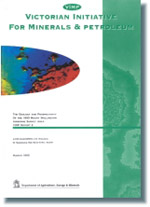VIMP Report 2 - The geology and prospectivity of the 1993 Mount Wellington airborne survey area
 |
| |||||||||||||||||||||||||||||
Product description:Download The downloadable version of this report is supplied in PDF format. Abstract This report describes the geology of an area in the eastern part of the Melbourne Zone in east-central Victoria, covered by portions of the Mansfield, Matlock, Howitt and Maffra 1:100 000 mapsheets (8123, 8122, 8223, 8222). It gives a comprehensive account of the geological history, Palaeozoic rocks units, structural and economic geology and of the aeromagnetic information, together with an extensive list of references. Particular emphasis is placed on the Lower Palaeozoic marine sedimentary rock sequence, which has been organized into groups consisting of mostly new formations. These include the Cambrian Licola, Jamieson and Lickhole Volcanics Groups (calc-alkaline and boninitic submarine volcanics), the Ordovician Cobbannah Group (siliciclastic turbidites), Howqua Shale and Mount Easton Shale, (deep marine black shale) and the (mostly) Silurian Jordan River Group (marine mudstones and siliciclastic turbidites). New group and formation names are also introduced for part of the Upper Devonian subaerial redbed and felsic volcanic sequence, which includes the Delatite, Mansfield and Avon River Groups. The rocks were affected by two deformations, the Tabberabberan Deformation in the Middle Devonian, which was the most important, and the Kanimblan Deformation in the Carboniferous. The Tabberabberan structures and tectonic evolution are described in terms of three thick thrust sheets separated by originally bedding parallel thrust faults (Thomas and Fullarton Thrusts). The Cambrian volcanics form the structurally lowest thrust sheet and in the Barkly River belt are exposed in a series of structural windows below the Thomas Thrust Fault. In the Howqua River area, the Cambrian volcanics outcrop in two eastward-facing vertical belts. Subsequent to thrusting, the rocks were folded into a series of northwest trending anticlinoria and synclinoria. The Kanimblan Deformation produced open to locally tight folds in the Upper Devonian rocks, and locally steep to overthrust margin faults, but its effects on the Lower Palaeozoic rocks was very localized. The geophysics chapter of this report contains the interpretation of the Mount Wellington airborne survey which was flown in 1993 for the Geological Survey of Victoria over the area covered by the Mount Useful Slate Belt geological map. The survey involved the collection of magnetic and radiometric data by helicopter and provided detailed information to assist field mapping. The Cambrian greenstones were clearly defined by the geophysical data and their subsurface extents could be interpreted. Sediments were defined by their low magnetic response. Regional northwest lineaments were visible in the magnetic data. Bibliographic reference VandenBerg, A.H.M., Willman, C.E., Hendrickx, M., Bush, M.D. & Sands, B.C., 1995. The geology and prospectivity of the 1993 Mount Wellington Airborne Survey area. Geological Survey of Victoria VIMP Report 2. Department of Agriculture, Energy and Minerals. Related products:
| ||||||||||||||||||||||||||||||



